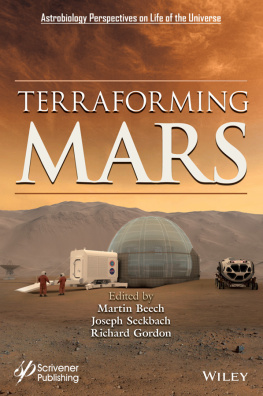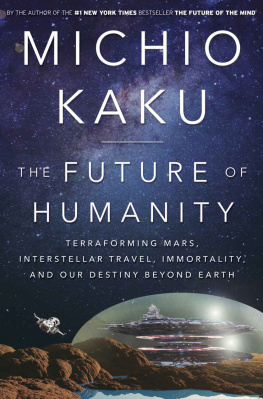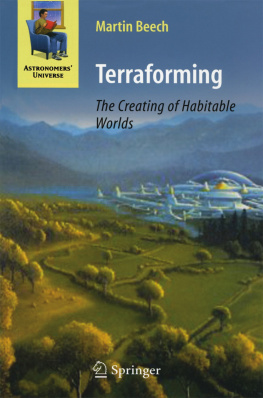
Scrivener Publishing
100 Cummings Center, Suite 541J
Beverly, MA 01915-6106
Astrobiology Perspectives on Life of the Universe
Series Editors: Richard Gordon and Joseph Seckbach
In his 1687 book Principia, Isaac Newton showed how a body launched atop a tall mountain parallel to the ground would circle the Earth. Many of us are old enough to have witnessed the realization of this dream in the launch of Sputnik in 1957. Since then our ability to enter, view and understand the Universe has increased dramatically. A great race is on to discover real extraterrestrial life, and to understand our origins, whether on Earth or elsewhere. We take part of the title for this new series of books from the pioneering thoughts of Svante Arrhenius, who reviewed this quest in his 1909 book The Life of the Universe as Conceived by Man from the Earliest Ages to the Present Time. The volumes in Astrobiology Perspectives on Life of the Universe will each delve into an aspect of this adventure, with chapters by those who are involved in it, as well as careful observers and assessors of our progress. Guest editors are invited from time to time, and all chapters are peer-reviewed.
Publishers at Scrivener
Martin Scrivener ()
Phillip Carmical ()
Terraforming Mars
Edited by
Martin Beech
University of Regina and Campion College, Saskatchewan, Canada
Joseph Seckbach
The Hebrew University of Jerusalem, Israel
and
Richard Gordon
Gulf Specimen Marine Laboratory & Aquarium, Panacea, FL, USA and Wayne State University, Detroit, MI, USA

This edition first published 2022 by John Wiley & Sons, Inc., 111 River Street, Hoboken, NJ 07030, USA and Scrivener Publishing LLC, 100 Cummings Center, Suite 541J, Beverly, MA 01915, USA
2022 Scrivener Publishing LLC
For more information about Scrivener publications please visit www.scrivenerpublishing.com.
All rights reserved. No part of this publication may be reproduced, stored in a retrieval system, or transmitted, in any form or by any means, electronic, mechanical, photocopying, recording, or otherwise, except as permitted by law. Advice on how to obtain permission to reuse material from this title is available at http://www.wiley.com/go/permissions.
Wiley Global Headquarters
111 River Street, Hoboken, NJ 07030, USA
For details of our global editorial offices, customer services, and more information about Wiley products visit us at www.wiley.com.
Limit of Liability/Disclaimer of Warranty
While the publisher and authors have used their best efforts in preparing this work, they make no representations or warranties with respect to the accuracy or completeness of the contents of this work and specifically disclaim all warranties, including without limitation any implied warranties of merchant-ability or fitness for a particular purpose. No warranty may be created or extended by sales representatives, written sales materials, or promotional statements for this work. The fact that an organization, website, or product is referred to in this work as a citation and/or potential source of further information does not mean that the publisher and authors endorse the information or services the organization, website, or product may provide or recommendations it may make. This work is sold with the understanding that the publisher is not engaged in rendering professional services. The advice and strategies contained herein may not be suitable for your situation. You should consult with a specialist where appropriate. Neither the publisher nor authors shall be liable for any loss of profit or any other commercial damages, including but not limited to special, incidental, consequential, or other damages. Further, readers should be aware that websites listed in this work may have changed or disappeared between when this work was written and when it is read.
Library of Congress Cataloging-in-Publication Data
ISBN 978-1-119-76196-9
Cover images: Courtesy of Martin Beech
Cover design by Russell Richardson
Set in size of 11pt and Minion Pro by Manila Typesetting Company, Makati, Philippines
Printed in the USA
10 9 8 7 6 5 4 3 2 1
Preface
I would like to die on Mars, just not on impact. Elon Musk
In February 2021 three spacecraft, from three different space agencies arrived at Mars. Two of these, the United Arab Emirates Hope, and Chinas Tianwen-1, joined a host of other space platforms already in Mars orbits, while the third, NASAs Perseverance Rover, proceeded to land safely in Jezero crater upon the Martian surface. This unprecedented international success story has been long in the making, but it marks a distinct acceleration in humanities effort to explore planet Mars. These three spacecraft and associated landers, along with their previously arrived orbital comrades, will deep search the Martian atmosphere, analyse weather cycles and dust clouds, photograph and probe surface topology and composition, as well as look for signs of past, and possible present-day, life. To say that Mars exploration is flourishing seems like an understatement. Indeed, while Mars has been the object of human imaginative exploration for centuries, it is only a little more than a half-century ago that the first fleeting glimpses of its actual surface were revealed by the Mariner 4 spacecraft flyby. Since that time, and the return of those first grainy images, the Martian surface has been mapped and measured in incredible detail - we know the Martian landscape almost as well as we known that of the Earths. For all this, Mars is still mysterious and remote - the first human being has yet to plant the first, epoch-changing, foot-print into its red-coloured soil. This remoteness, however, is surely due to change within the next half-century. Humans will walk on Mars, and they will eventually live and die there in large communities housed within vast, above and underground, settlements. Concomitant to, and in parallel with the establishment of the first settlements industry will follow - the early settlers of Mars will have to earn, and justify their upkeep. Exactly how all this industrialization and settlement will proceed is entirely unclear at the present time, which is not to say that much research and hyperbole hasnt been published. Settlement will happen, but in what manner and when is something that our future-gaze can but dimly see. Like some pointillist picture the greater vista of Marss future seems clear but it grows more indistinct the closer the inspection proceeds. For all this, we are on the cusp of change, and Mars patiently awaits its first human visitors. Furthermore, somewhere along the deeper future timeline, when all the hoopla of first landings, settlement construction, and city development is the fodder of stayed news stories, set on the obscure back pages of the Vancouver Sun newspaper, a new epoch of even greater revolution might possibly unfold. At some future time, set perhaps within the next century, it may be deemed desirable to terraform Mars. The question is not so much can Mars be transformed, the technology to achieve this goal largely exists today, but why and for whom. Currently it is these latter issues that require much greater thought and consideration - let us not repeat the many colonialist disasters and environmental failures long-wrought by humanity against the Earth on Mars. The path leading to the successful and meaningful transformation of Mars will be a narrow and difficult one to tread, but the potential benefits of making its surface better-suited to human activity and physiology, even if it is never made fully Earth-like, may well prove irresistible to the future citizens of the planet.
Next page













